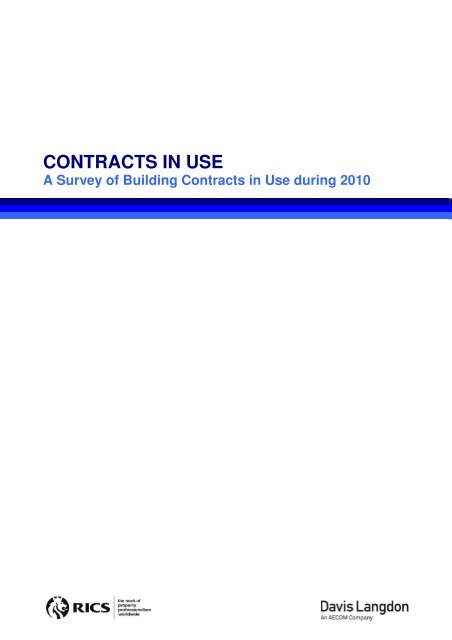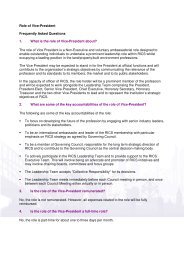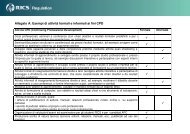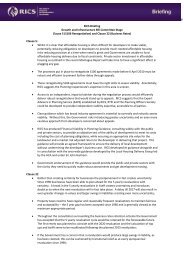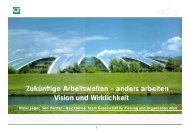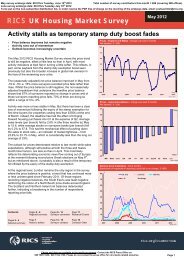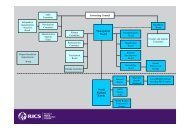Contracts in Use Survey 2010 - RICS
Contracts in Use Survey 2010 - RICS
Contracts in Use Survey 2010 - RICS
Create successful ePaper yourself
Turn your PDF publications into a flip-book with our unique Google optimized e-Paper software.
CONTRACTS IN USE<br />
A <strong>Survey</strong> of Build<strong>in</strong>g <strong>Contracts</strong> <strong>in</strong> <strong>Use</strong> dur<strong>in</strong>g <strong>2010</strong>
Introduction<br />
This is the twelfth <strong>in</strong> a series of surveys to determ<strong>in</strong>e trends <strong>in</strong> the use of standard forms of<br />
contract and procurement methods. This report has been prepared by Davis Langdon on behalf of<br />
the <strong>RICS</strong> Built Environment.<br />
As with previous surveys, a questionnaire was sent to all private practices and public authorities<br />
listed by <strong>RICS</strong> as employ<strong>in</strong>g chartered quantity surveyor members. Contract<strong>in</strong>g organisations<br />
employ<strong>in</strong>g surveyor members were not sampled to avoid the possibility of double count<strong>in</strong>g of<br />
contracts.<br />
The scope of the survey encompassed projects for which work on site started dur<strong>in</strong>g the calendar<br />
year, 1 January to 31 December <strong>2010</strong>. The survey has attempted to sample all build<strong>in</strong>g work<br />
carried out <strong>in</strong> the United K<strong>in</strong>gdom, both new build and refurbishment. <strong>Survey</strong> respondents were<br />
asked to exclude specifically all overseas work, civil eng<strong>in</strong>eer<strong>in</strong>g work and heavy eng<strong>in</strong>eer<strong>in</strong>g<br />
projects. In addition, term contracts, rout<strong>in</strong>e ma<strong>in</strong>tenance and repair work and sub-contracts<br />
form<strong>in</strong>g part of larger contracts were also asked to be excluded.<br />
Page 2
<strong>Contracts</strong> <strong>in</strong> use<br />
<strong>2010</strong> <strong>Survey</strong><br />
Introduction 2<br />
List of Tables 5<br />
List of Charts 5<br />
Executive Summary 6<br />
General procurement methods <strong>2010</strong> 7<br />
Response 9<br />
Analysis of returns 10<br />
Standard forms of contract 11<br />
JCT Forms 13<br />
ICE Forms 18<br />
NEC Family of <strong>Contracts</strong> 18<br />
GC/Works <strong>Contracts</strong> 21<br />
PC/Works Forms 21<br />
Association of Consultant Architects 22<br />
Other Standard Forms of Contract 23<br />
Non Standard Forms 23<br />
Partner<strong>in</strong>g Arrangements 23<br />
Additional contract provisions 24<br />
Negotiated <strong>Contracts</strong> 24<br />
Fluctuat<strong>in</strong>g Price <strong>Contracts</strong> 25<br />
Guaranteed Maximum Price 25<br />
Two Stage Procurement 26<br />
Incentivisation 28<br />
Electronic Tender<strong>in</strong>g 28<br />
Framework Agreements 28<br />
Private F<strong>in</strong>ance Initiative / 29<br />
Public Private Partnership<br />
Page 3
Analysis of <strong>Contracts</strong> <strong>Use</strong>d by Contract Value 30<br />
Procurement Methods 35<br />
Bills of Quantities 35<br />
Specification and Draw<strong>in</strong>gs / Activity Schedules 35<br />
Design and build procurement 36<br />
Target <strong>Contracts</strong> 37<br />
Prime Cost <strong>Contracts</strong> 38<br />
Management <strong>Contracts</strong> 38<br />
Construction Management 38<br />
Partner<strong>in</strong>g 39<br />
Appendix 1 – <strong>Survey</strong> questionnaire 41<br />
Appendix 2 – The distribution of contracts <strong>in</strong> use 42<br />
Page 4
List of tables<br />
Table 1: Trends <strong>in</strong> Methods of Procurement – by number of contracts 8<br />
Table 2: Trends <strong>in</strong> Methods of Procurement – by value of contracts 8<br />
Table 3: Response to the <strong>Survey</strong> 9<br />
Table 4: <strong>Use</strong> of Standard Forms of Contract 11<br />
Table 5: Long Term Trends <strong>in</strong> the use of JCT Standard Forms 13<br />
Table 6: <strong>Use</strong> of JCT Standard Forms 14<br />
List of charts<br />
Chart 1: Distribution of methods of procurement – by number of contracts 7<br />
Chart 2: Distribution of methods of procurement – by value of contracts 7<br />
Chart 3: Distribution of contracts by value bands (number of contracts) 10<br />
Chart 4: <strong>Use</strong> of Standard Forms of Contract (by number of contracts) 11<br />
Chart 5: <strong>Use</strong> of Standard Forms of Contract (by value of contracts) 12<br />
Chart 6: The 2005 Intermediate Build<strong>in</strong>g Contract 15<br />
Chart 7: JCT Design and Build <strong>Contracts</strong> 16<br />
Chart 8: The proportion of contracts employ<strong>in</strong>g an NEC Contract 19<br />
Chart 9: <strong>Use</strong> of NEC Options (by number) 20<br />
Chart 10: Occurrences of GC/Works <strong>Contracts</strong> 21<br />
Chart 11: <strong>Use</strong> of ACA Standard Form of Project Partner<strong>in</strong>g (PPC2000) 22<br />
Chart 12: The rise and fall of negotiation 24<br />
Chart 13: The use of negotiation by contract size 25<br />
Chart 14: The rise and fall of Guaranteed Maximum Price provisions 26<br />
Chart 15: The use of two stage procurement (by contract number) 26<br />
Chart 16: The use of two stage procurement (by contract value) 27<br />
Chart 17: The use of two stage procurement by size of contract 27<br />
Chart 18: Framework agreements 29<br />
Chart 19: <strong>Use</strong> of Bills of Quantities 35<br />
Chart 20: Specification and Draw<strong>in</strong>gs / Activity Schedules by project value 36<br />
Chart 21: <strong>Use</strong> of Design and Build procurement 37<br />
Chart 22: Target contracts 38<br />
Chart 23: Partner<strong>in</strong>g Agreements and Arrangements by contract value 40<br />
Page 5
Executive Summary<br />
The survey captured contract details represent<strong>in</strong>g only a disappo<strong>in</strong>t<strong>in</strong>g 3.9% of the value of new<br />
orders <strong>in</strong> <strong>2010</strong>. The conclusions should be read with this <strong>in</strong> m<strong>in</strong>d.<br />
• Over 97% of construction projects use a standard form of contract<br />
• 88% of projects used one of the JCT family of contracts, up from 79% <strong>in</strong> 2007 and 78% <strong>in</strong><br />
2004<br />
• All other forms of contract showed a reduction <strong>in</strong> usage<br />
• The JCT Intermediate Form with Quantities and the M<strong>in</strong>or Works Form showed the greatest<br />
<strong>in</strong>crease <strong>in</strong> use; the IFC was most commonly used on contracts of £250,000 to £1m value<br />
but the form was used on significant numbers of contracts up to £5m <strong>in</strong> value<br />
• The JCT M<strong>in</strong>or Works Build<strong>in</strong>g Contract is the most commonly used form of contract <strong>in</strong><br />
Great Brita<strong>in</strong><br />
• The JCT Design and Build Contract is the most commonly used contract for projects <strong>in</strong> the<br />
ranges of £500,000 to £10m and £20m to £50m<br />
• Some <strong>in</strong>crease has been captured <strong>in</strong> the use of the Major Project Construction Contract but<br />
only with projects <strong>in</strong> the £5-10m value range<br />
• The use of ICE forms of contract has been <strong>in</strong> decl<strong>in</strong>e over the last three surveys<br />
• Numerically the use of NEC contracts is largely unchanged but NEC now accounts for a<br />
larger value of projects with its greater use on projects over £5m <strong>in</strong> value<br />
• The use of GC/Works contracts has decl<strong>in</strong>ed sharply<br />
• The use of the ACA Standard Form of Project Partner<strong>in</strong>g has fallen away, particularly <strong>in</strong><br />
conjunction with higher value projects<br />
• The use of negotiated contracts has decl<strong>in</strong>ed from its peak <strong>in</strong> 2007<br />
• Two stage procurement has fallen back from the peak of its popularity <strong>in</strong> 2007<br />
• Little use cont<strong>in</strong>ues to be made of electronic tender<strong>in</strong>g arrangements<br />
• The number of projects secured under a framework arrangement has fallen compared to<br />
2007 but, <strong>in</strong> <strong>2010</strong>, frameworks were used on a higher value of projects and <strong>in</strong> conjunction<br />
with a wider spread of project sizes<br />
• The use of Bills of Quantities <strong>in</strong>creased <strong>in</strong> <strong>2010</strong> compared to 2007 and BQs are used <strong>in</strong><br />
almost 25% of build<strong>in</strong>g contracts<br />
• NEC Target contracts are now used <strong>in</strong> over 25% of contracts over £10m <strong>in</strong> value<br />
• Only three <strong>in</strong>stances have been recorded of the use of construction management (all on<br />
small projects) and no <strong>in</strong>stances recorded of management contract<strong>in</strong>g for the first time <strong>in</strong><br />
the survey’s history<br />
• Partner<strong>in</strong>g with the use of formal agreements and arrangements has decl<strong>in</strong>ed. Only 2% by<br />
number and value of recorded projects <strong>in</strong>volved any form of partner<strong>in</strong>g agreement or<br />
arrangement<br />
Page 6
General procurement methods <strong>2010</strong><br />
Chart 1:<br />
Distribution of methods of procurement - by number of contracts<br />
Chart 2:<br />
Distribution of methods of procurement - by value of contracts<br />
Page 7
General procurement methods <strong>2010</strong><br />
Table 1:<br />
Trends <strong>in</strong> Methods of Procurement - by numbers of contracts<br />
1987<br />
%<br />
1989<br />
%<br />
1991<br />
%<br />
1993<br />
%<br />
Lump Sum – Firm BQ 35.6 39.7 29.0 34.5 39.2 30.8 19.6 30.0 20.0 24.5<br />
Lump Sum – Spec &<br />
Draw<strong>in</strong>gs<br />
Lump Sum – Design &<br />
Build<br />
1995<br />
%<br />
1998<br />
%<br />
2001<br />
%<br />
2004<br />
%<br />
Page 8<br />
2007<br />
%<br />
<strong>2010</strong><br />
%<br />
55.4 49.7 59.2 45.6 43.7 43.9 62.9 42.7 47.2 52.1<br />
3.6 5.2 9.1 16.0 11.8 20.7 13.9 13.3 21.8 17.5<br />
Target contracts - - - - - - - 6.0 4.5 3.7<br />
Remeasurement – Approx.<br />
BQ<br />
1.9 2.9 1.5 2.3 2.1 1.9 1.7 4.0 1.7 0.3<br />
Prime Cost Plus Fixed Fee 2.3 0.9 0.2 0.3 0.7 0.3 0.2 0.2 0.5 0.6<br />
Management Contract 1.2 1.4 0.8 0.9 1.2 1.5 0.6 0.2 0.7 0.0<br />
Construction Management - 0.2 0.2 0.4 1.3 0.8 0.4 0.9 1.1 0.3<br />
Partner<strong>in</strong>g Agreements - - - - - - 0.6 2.7 2.3 1.0<br />
Total 100.0 100.0 100.0 100.0 100.0 100.0 100.0 100.0 100.0 100.0<br />
Table 2:<br />
Trends <strong>in</strong> Methods of Procurement - by value of contracts<br />
1987<br />
%<br />
1989<br />
%<br />
1991<br />
%<br />
1993<br />
%<br />
Lump Sum – Firm BQ 52.1 52.3 48.3 41.6 43.7 28.4 20.3 23.2 13.2 18.8<br />
Lump Sum – Spec &<br />
Draw<strong>in</strong>gs<br />
Lump Sum – Design &<br />
Build<br />
1995<br />
%<br />
1998<br />
%<br />
2001<br />
%<br />
2004<br />
%<br />
2007<br />
%<br />
<strong>2010</strong><br />
%<br />
17.7 10.2 7.0 8.3 12.2 10.0 20.2 10.7 18.2 22.6<br />
12.2 10.9 14.8 35.7 30.1 41.4 42.7 43.2 32.6 39.2<br />
Target contracts - - - - - - - 11.6 7.6 17.1<br />
Remeasurement – Approx.<br />
BQ<br />
3.4 3.6 2.5 4.1 2.4 1.7 2.8 2.9 2.0 0.7<br />
Prime Cost Plus Fixed Fee 5.2 1.1 0.1 0.2 0.5 0.3 0.3
Response<br />
The response to the survey is set out <strong>in</strong> Table 3 alongside the equivalent figures from the<br />
most recent surveys for comparison.<br />
Table 3:<br />
Response to the survey<br />
1995 1998 2001 2004 2007 <strong>2010</strong><br />
Number of surveys returned 194 151 230 143 83 86<br />
Number of projects captured 4652 2457 2955 2330 1370 1018<br />
Value of projects captured £3224m £4767m £3337m £3035m £7813m £1673m<br />
Average value of project £0.69m £1.94m £1.13m £1.30m £5.05m £1.64m<br />
Average value (<strong>2010</strong> prices) £1.15m £2.88m £1.41m £1.32m £5.70m £1.64m<br />
Proportion of total value of new orders 11.6% 13.3% 8.7% 5.6% 11.3% 3.9%<br />
The number of survey returns was similar to the 2007 survey but the number of projects<br />
captured was lower and was by far the lowest <strong>in</strong> the survey’s history. This is also<br />
reflected <strong>in</strong> the value of projects captured which, aga<strong>in</strong>, was far lower than <strong>in</strong> any<br />
previous surveys. However the average value of project captured was more <strong>in</strong> l<strong>in</strong>e with<br />
most previous surveys (the 2007 survey was the odd one out with a much higher average<br />
project value).<br />
The proportion of the total value of new orders has been reduced for all previous surveys<br />
follow<strong>in</strong>g revision by the Office for National Statistics of its ‘Value of orders for new<br />
construction’ statistics. Revised methodology has suggested that previously published<br />
data under-estimated the value of work <strong>in</strong> the <strong>in</strong>dustry. Us<strong>in</strong>g the revised figures<br />
suggests that these surveys have sampled a smaller proportion of work than previously<br />
believed. The figure for <strong>2010</strong> is perhaps the most disappo<strong>in</strong>t<strong>in</strong>g of all, suggest<strong>in</strong>g that the<br />
survey has captured only 3.9% of new work <strong>in</strong> Great Brita<strong>in</strong>. It is possible that some work<br />
for which orders were placed <strong>in</strong> <strong>2010</strong> failed to start on site but this proportion would be<br />
only small.<br />
The unique characteristics of the 2007 survey may mean that the <strong>2010</strong> results may be<br />
more comparable with earlier surveys and this should be borne <strong>in</strong> m<strong>in</strong>d when compar<strong>in</strong>g<br />
results. The relatively small percentage of the total market represented by the survey<br />
should also be borne <strong>in</strong> m<strong>in</strong>d when apply<strong>in</strong>g the results to the <strong>in</strong>dustry as a whole.<br />
The current survey has recorded only a s<strong>in</strong>gle <strong>in</strong>stance of a project over £50m <strong>in</strong> value,<br />
compared to 28 <strong>in</strong> the 2007 survey and 4 <strong>in</strong> the 2004 survey. In some respects this is<br />
representative of the smaller value projects that characterise the <strong>in</strong>dustry s<strong>in</strong>ce the onset<br />
of the recession but also suggests an under-representation of larger schemes <strong>in</strong> the<br />
survey. Not a s<strong>in</strong>gle PPP/PFI project is <strong>in</strong>cluded <strong>in</strong> the survey.<br />
Page 9
Analysis of returns<br />
Distribution of <strong>Contracts</strong><br />
Appendix 2 shows the cumulative results of the survey and the distribution of contracts <strong>in</strong><br />
use <strong>in</strong> <strong>2010</strong>. As <strong>in</strong> previous surveys, contracts are arranged <strong>in</strong> value bands. Chart 3<br />
shows the distribution of contracts by value <strong>in</strong> this survey.<br />
Chart 3:<br />
Distribution of contracts by value bands (number of contracts)<br />
<strong>Contracts</strong> of less than £250,000 <strong>in</strong> value accounted for 36% of the sample. This is<br />
slightly more than <strong>in</strong> 2007 (29%) but less than <strong>in</strong> 2004 (50%) and 2001 (58%).<br />
Page 10
Contract Family<br />
Standard forms of contract<br />
The vast majority of construction contracts still use one of the standard forms of contract,<br />
albeit sometimes with client or consultant amendments. Only 2.6% by number and 1.9%<br />
by value have used a non-standard form of contract, almost exactly the same as <strong>in</strong> the<br />
2007 survey.<br />
Table 4:<br />
<strong>Use</strong> of Standard Forms of Contract<br />
% used by<br />
number<br />
Compared<br />
to 2007<br />
% used by<br />
value<br />
Page 11<br />
Compared<br />
to 2007<br />
JCT 88.0 ↑ 67.2 ↑<br />
ICE 0.4 ↓ 1.6 ↓<br />
NEC 7.4 ↓ 26.4 ↑<br />
GC/Works 0.8 ↓ 2.2 ↓<br />
ACA 0.9 ↓ 0.8 ↓<br />
Prime Contract<strong>in</strong>g Agreement 0.0 ↓ 0.0 ↓<br />
Other standard forms 0.0 ↓ 0.0 ↓<br />
Other contracts 2.5 ↑ 1.9 ↑<br />
Chart 4:<br />
<strong>Use</strong> of Standard Forms of Contract (by number of contracts)<br />
ICE<br />
0.4%<br />
GC/Works<br />
0.8%<br />
ACA<br />
0.9%<br />
NEC<br />
7.4%<br />
JCT<br />
88.0%<br />
Other contracts<br />
2.5%<br />
JCT<br />
ICE<br />
NEC<br />
GC/Works<br />
ACA<br />
Other contracts
Chart 5:<br />
<strong>Use</strong> of Standard Forms of Contract (by value of contracts)<br />
ICE<br />
1.5%<br />
GC/Works<br />
2.2%<br />
NEC<br />
26.4%<br />
ACA<br />
0.8%<br />
Other contracts<br />
1.9%<br />
JCT<br />
67.2%<br />
JCT<br />
ICE<br />
NEC<br />
GC/Works<br />
ACA<br />
Other contracts<br />
Page 12
JCT forms<br />
The JCT standard forms cont<strong>in</strong>ue to dom<strong>in</strong>ate the construction contracts market: with<strong>in</strong><br />
the survey sample, 88% of all contracts by number employed a JCT standard form, up<br />
from 79% <strong>in</strong> 2007 and close to the 91% <strong>in</strong> 1998 and 2001. By value, the proportion of<br />
contracts employ<strong>in</strong>g one of the JCT family of contracts rose from 62% <strong>in</strong> 2007, the<br />
second lowest figure recorded <strong>in</strong> the 25 years survey history, to 67% <strong>in</strong> <strong>2010</strong> but still<br />
lower than the long term average.<br />
Table 5:<br />
Long Term Trends <strong>in</strong> the use of JCT Standard Forms<br />
Percentage of total number<br />
1985 1987 1989 1991 1993 1995 1998 2001 2004 2007 <strong>2010</strong><br />
% % % % % % % % % % %<br />
81 86 81 78 82 85 91 91 78 79 88<br />
Percentage of total value 70 74 81 61 80 76 68 79 70 62 67<br />
By value the proportion has always recorded a slightly lower percentage than by number.<br />
This is because higher value schemes have had a greater tendency to employ some<br />
alternative form of contract such as construction management, NEC or PPC 2000. In<br />
<strong>2010</strong>, only 54% of contracts over £10m employed a JCT contract with NEC clos<strong>in</strong>g the<br />
gap with 39% of such contracts.<br />
The 2007 survey identified that 1998 versions of the JCT contracts were still <strong>in</strong> regular<br />
use. However less than 2% of JCT contracts used <strong>in</strong> <strong>2010</strong> were of 1998 (or earlier)<br />
v<strong>in</strong>tage. Of these, the 1998 M<strong>in</strong>or Works edition was the most commonly still<br />
encountered<br />
Table 6 plots the breakdown by type of JCT form, show<strong>in</strong>g a comparison with previous<br />
surveys.<br />
Page 13
Table 6:<br />
<strong>Use</strong> of JCT Standard Forms (irrespective of edition)<br />
JCT Standard Contract<br />
Form Percentage by Number Percentage by Value<br />
2001 2004 2007 <strong>2010</strong> 2001 2004 2007 <strong>2010</strong><br />
with quantities 8.5 14.9 11.7 12.5 12.7 18.4 10.2 11.2<br />
without quantities 4.6 5.3 6.2 4.8 10.4 3.6 7.8 5.0<br />
with approximate quantities 0.4 2.6 0.9 0.2 0.9 2.5 1.5 0.2<br />
Design and Build 13.3 11.2 19.4 15.7 39.7 35.6 25.3 33.4<br />
Intermediate Form with quantities 9.4 11.8 6.7 10.7 5.2 3.5 1.1 6.2<br />
Intermediate Form without quants 14.0 8.1 8.5 9.3 4.8 2.4 1.4 3.8<br />
M<strong>in</strong>or Works 40.0 23.5 23.5 33.0 2.9 2.4 0.9 4.9<br />
Prime Cost Contract 0.2 0.1 0.4 0.1 0.3
Standard Build<strong>in</strong>g Contract<br />
with quantities<br />
The vast majority (85%) of the JCT Standard Build<strong>in</strong>g Contract with Quantities <strong>in</strong>volved<br />
contractor’s design. Only 18 of the 122 uses of the Standard Build<strong>in</strong>g Contract used the<br />
‘without contractor’s design’ variant, slightly more than <strong>in</strong> 2007 (6%).<br />
with approximate quantities<br />
Only 2 cases of the ‘with approximate quantities’ variant were recorded <strong>in</strong> this survey.<br />
without quantities<br />
<strong>Use</strong> of the ‘without quantities’ variant decl<strong>in</strong>ed slightly compared to 2007 but only a s<strong>in</strong>gle<br />
example was recorded of the ‘without contractor’s design’ sub-variant. 87% of usage was<br />
<strong>in</strong> connection with projects below £2m <strong>in</strong> value.<br />
Intermediate Build<strong>in</strong>g Contract<br />
The use of the Intermediate Build<strong>in</strong>g Contract, both with and without quantities, has<br />
<strong>in</strong>creased compared to 2007 <strong>in</strong> both number and value terms. No <strong>in</strong>stances were<br />
recorded of use on contracts over £5m <strong>in</strong> value but the orig<strong>in</strong>al <strong>in</strong>tention was that this<br />
form was to be used on contracts up to around £500,000. 56% of uses of the<br />
Intermediate Form were <strong>in</strong> connection with contracts over £500,000.<br />
45% of Intermediate forms used the ‘with contractor’s design’ variant, compared to 88%<br />
of the Standard Form. 53% were ‘with quantities’ compared to 47% ‘without’.<br />
5 <strong>in</strong>stances (2%) were recorded of pre-2005 editions be<strong>in</strong>g used.<br />
The follow<strong>in</strong>g chart shows the proportion of projects us<strong>in</strong>g the various alternative options,<br />
with and without quantities, with and without contractor’s design, of the 2005 Intermediate<br />
Build<strong>in</strong>g Contract.<br />
Chart 6:<br />
The 2005 Intermediate Build<strong>in</strong>g Contract<br />
Page 15
M<strong>in</strong>or Works Build<strong>in</strong>g Contract<br />
The use of the M<strong>in</strong>or Works Form <strong>in</strong>creased <strong>in</strong> <strong>2010</strong> by both number and value compared<br />
to both 2007 and 2004.<br />
The ‘with contractor’s design’ variant was used <strong>in</strong> 35% of <strong>in</strong>stances, up from 14% <strong>in</strong> 2007.<br />
The M<strong>in</strong>or Works form was orig<strong>in</strong>ally recommended for use on contracts up to about<br />
£150,000 (at <strong>2010</strong> prices). The Form was used on projects up to £2m <strong>in</strong> value but 76%<br />
of usage was <strong>in</strong> connection with contracts up to £250,000 (the lowest value band<br />
surveyed).<br />
8 <strong>in</strong>stances (2%) used a pre-2005 version of the form.<br />
Design and Build Contract<br />
Of the JCT family of contracts, the use of the Design and Build Contract <strong>in</strong> <strong>2010</strong><br />
proportionally decl<strong>in</strong>ed by number overall but <strong>in</strong>creased by value compared to 2007. The<br />
latter is illustrated <strong>in</strong> Chart 8 with the <strong>in</strong>creased use of the contract with projects <strong>in</strong> the<br />
£20-50m value range. However its use appears to have fallen <strong>in</strong> the £10-20m project<br />
value range.<br />
Chart 7:<br />
JCT Design and Build <strong>Contracts</strong><br />
No <strong>in</strong>stances were recorded of use of pre-2005 editions of the Design and Build Form.<br />
Major Project Construction Contract<br />
10 <strong>in</strong>stances were recorded of use of the Major Project Construction Contract, a 100%<br />
<strong>in</strong>crease on 2007 even though far fewer large projects were captured <strong>in</strong> this survey. All<br />
10 <strong>in</strong>stances were <strong>in</strong> connection with projects <strong>in</strong> the £5-10m range. Projects above this<br />
value mostly used the Design and Build Contract.<br />
Page 16
Construction Management<br />
Only 3 <strong>in</strong>stances were recorded of the use of the JCT Construction Management forms,<br />
all on projects under £1m value.<br />
Management Build<strong>in</strong>g Contract<br />
No <strong>in</strong>stances were recorded of use of the JCT Management Build<strong>in</strong>g Contract.<br />
Prime Cost Build<strong>in</strong>g Contract<br />
Only a s<strong>in</strong>gle use was recorded of the Prime Cost Build<strong>in</strong>g Contract, on a project <strong>in</strong> the<br />
£1-2m value range.<br />
Construct<strong>in</strong>g Excellence Contract<br />
A s<strong>in</strong>gle use was identified of the use of the Construct<strong>in</strong>g Excellence Contract (on a<br />
project <strong>in</strong> the £1-2m value range) follow<strong>in</strong>g no recorded <strong>in</strong>stances <strong>in</strong> 2007.<br />
Framework Agreement<br />
The JCT Framework Agreement 2007 superseded Framework Agreement 2005 but only<br />
a s<strong>in</strong>gle use was identified <strong>in</strong> the <strong>2010</strong> survey. This was <strong>in</strong> conjunction with a £250,000 -<br />
£500,000 value project.<br />
Partner<strong>in</strong>g Charter (Non-b<strong>in</strong>d<strong>in</strong>g)<br />
The JCT Partner<strong>in</strong>g Charter (Non-b<strong>in</strong>d<strong>in</strong>g) 2005 is <strong>in</strong>tended for use with most standard<br />
forms of construction where the parties do not wish to enter <strong>in</strong>to a legally b<strong>in</strong>d<strong>in</strong>g<br />
agreement but wish to create a collaborative work<strong>in</strong>g environment. The current survey<br />
identified four <strong>in</strong>stances of use of the charter, an improvement on the two <strong>in</strong>stances<br />
recorded <strong>in</strong> the 2007 survey but still well down on the use of the charter’s predecessor <strong>in</strong><br />
the 2004 survey (11 <strong>in</strong>stances). Three of the current uses were <strong>in</strong> connection with<br />
contracts <strong>in</strong> the £500,000 to £1m range with one with a contract <strong>in</strong> the £2-5m range.<br />
Page 17
ICE Forms<br />
Although the ICE family of forms were designed largely for use <strong>in</strong> connection with works<br />
of civil eng<strong>in</strong>eer<strong>in</strong>g construction, they are sometimes used for build<strong>in</strong>g works, particularly<br />
where large amounts of earthworks are <strong>in</strong>volved, and for this reason the forms cont<strong>in</strong>ue<br />
to be <strong>in</strong>cluded <strong>in</strong> this survey.<br />
However, on this occasion, only 4 <strong>in</strong>stances of use of ICE forms were recorded. This<br />
compares with 16 <strong>in</strong>stances <strong>in</strong> 2007 and 31 <strong>in</strong>stances <strong>in</strong> 2004. In the two previous<br />
surveys, use of ICE forms accounted for only 1% of contracts used but <strong>in</strong> <strong>2010</strong>, the<br />
percentage dropped to 0.4%. In 2007 ICE forms accounted for 2% by value of all<br />
contracts, driven by two <strong>in</strong>stances of use of the Target Cost Version on contracts over<br />
£50m value. In <strong>2010</strong> the four <strong>in</strong>stances accounted for 1.6% of the contracts by value. On<br />
this occasion there were three uses of the Design & Construct form at vary<strong>in</strong>g project<br />
sizes (£250-500k, £2-5m and £10-20m) and one of the Measurement Version (£5-10m).<br />
There were no recorded <strong>in</strong>stances of use of the Target Cost Version <strong>in</strong> <strong>2010</strong>. Similarly<br />
no <strong>in</strong>stances were noted of use of the M<strong>in</strong>or Works form.<br />
For the third consecutive survey, no <strong>in</strong>stances were recorded of use of the ICE Partner<strong>in</strong>g<br />
Addendum.<br />
NEC Family of <strong>Contracts</strong><br />
NEC contracts accounted for 7.4% of all contracts <strong>in</strong> the survey by number and 26.4% by<br />
value. By number the percentage rema<strong>in</strong>s similar to the previous two surveys (7.7% <strong>in</strong><br />
2007 and 6.7% <strong>in</strong> 2004). However, by value the proportion of contracts <strong>in</strong> <strong>2010</strong> us<strong>in</strong>g<br />
NEC contracts rose considerably (14.0% <strong>in</strong> 2007 and 12.8% <strong>in</strong> 2004).<br />
This is a reflection of that fact that NEC contracts appear to have become more widely<br />
used on projects at the larger end of the spectrum. 44% of contracts over £5m used an<br />
NEC contract compared to 17% <strong>in</strong> 2007.<br />
The follow<strong>in</strong>g chart shows the proportion of each value band <strong>in</strong> which an NEC contract<br />
was used, compar<strong>in</strong>g the 2007 and <strong>2010</strong> surveys.<br />
Page 18
Chart 8:<br />
The proportion of contracts employ<strong>in</strong>g an NEC Contract<br />
This clearly demonstrates the <strong>in</strong>creased frequency of use on projects over £5m <strong>in</strong> value.<br />
(Only one contract was recorded over £50m value, hence the 100% read<strong>in</strong>g)<br />
Option C Target Contract with Activity Schedule cont<strong>in</strong>ues to be the favourite NEC<br />
contract, used on 47% of occasions (though down from 55% <strong>in</strong> 2007 and 77% <strong>in</strong> 2004).<br />
The use of Option A Priced Contract with Activity Schedule has risen, up to 39% of<br />
usages from 33% <strong>in</strong> 2007.<br />
Chart 10 shows the comparative use of the various NEC options, whether NEC2 or<br />
NEC3, irrespective of value band.<br />
Page 19
Chart 9:<br />
<strong>Use</strong> of NEC Options (by number)<br />
Neither Option E Cost Reimbursable Contract nor Option F Management Contract<br />
recorded any usage <strong>in</strong> this survey.<br />
Option C Target Contract with Activity Schedule was used throughout the value bands,<br />
largely between £500,000 and £50m though its predom<strong>in</strong>ant use was <strong>in</strong> the £500,000 to<br />
£1m range.<br />
Option A Priced Contract with Activity Schedule was largely used on projects <strong>in</strong> the range<br />
of £250,000 to £10m value but s<strong>in</strong>gle examples were recorded at opposite ends of the<br />
value ranges i.e. less than £250,000 and over £50m.<br />
The three recorded usages of the Short Contract (ECSC) were all with projects under<br />
£250,000 value.<br />
NEC2 1995 edition was still used on 10 occasions (or 13% of NEC usage). The majority<br />
of these used the NEC2 Option A Priced Contract with Activity Schedule and only on<br />
projects up to £5m <strong>in</strong> value.<br />
Option X12 is the NEC’s Partner<strong>in</strong>g Option, <strong>in</strong>tended for use as a secondary option as<br />
part of the NEC family of contracts. In the 2004 survey, 11% of all the NEC contracts<br />
were comb<strong>in</strong>ed with Option X12, slipp<strong>in</strong>g to 9% <strong>in</strong> the 2007 survey. In the <strong>2010</strong> survey,<br />
not a s<strong>in</strong>gle example of the use of Option X12 was identified, <strong>in</strong>dicat<strong>in</strong>g, <strong>in</strong> conjunction<br />
with similar trends with other contract forms, the reduction <strong>in</strong> the formal use of partner<strong>in</strong>g<br />
or collaborative tools.<br />
Four <strong>in</strong>stances were identified of the use of NEC contracts <strong>in</strong> conjunction with ProCure 21<br />
or ProCure 21+, the NHS Estates’ preferred means of procur<strong>in</strong>g construction. This<br />
probably suggests that this item <strong>in</strong> the survey questionnaire was not fully taken note of.<br />
Page 20
GC/Works <strong>Contracts</strong><br />
If the <strong>2010</strong> survey sample is representative of the <strong>in</strong>dustry as a whole, it <strong>in</strong>dicates a sharp<br />
fall off <strong>in</strong> the use of GC/Works contracts. Only 8 <strong>in</strong>stances were recorded of the use of<br />
one or other of the GC/Works variants, represent<strong>in</strong>g just 0.8% of the sample by number<br />
and 2.2% by value. However the 2007 survey was abnormal <strong>in</strong> the number of <strong>in</strong>stances<br />
recorded (6% by number) while previous surveys had recorded 1.0 to 1.6% usage.<br />
Chart 10:<br />
Occurrences of GC/Works <strong>Contracts</strong><br />
All of the contracts (bar one) were <strong>in</strong> conjunction with small projects below £500,000 <strong>in</strong><br />
value.<br />
The s<strong>in</strong>gle example of use of Part 3 S<strong>in</strong>gle Stage Design & Build contract was <strong>in</strong><br />
conjunction with a £20-50m project.<br />
No examples were recorded of use of Part 5 Two Stage Design & Build, Part 6<br />
Construction Management nor GC/Works/4 Small works. The 2007 survey found 20<br />
<strong>in</strong>stances of use of the latter contract. The Construction Management form had not<br />
recorded any usage <strong>in</strong> the 2004 or 2007 surveys either.<br />
Ma<strong>in</strong>ta<strong>in</strong><strong>in</strong>g the trends observed with other forms of contract, no use of GC/Works1<br />
Amendment 1 (Achiev<strong>in</strong>g Excellence) was identified. This follows a similar lack of<br />
identified use <strong>in</strong> 2004 and 2007.<br />
PC/Works Forms<br />
The PC/Works (1998) suite of contracts was <strong>in</strong>troduced as an adapted form of GC/Works<br />
for use by private sector, local authority, NHS trust and all non-Central Government<br />
employers.<br />
Page 21
It has never achieved much use s<strong>in</strong>ce its <strong>in</strong>troduction and not a s<strong>in</strong>gle occurrence has<br />
been recorded <strong>in</strong> either of the last two surveys.<br />
Association of Consultant Architects<br />
The ACA Standard Form of Project Partner<strong>in</strong>g (PPC2000) was promoted as the first<br />
Standard Form Project Partner<strong>in</strong>g Contract and was published <strong>in</strong> September 2000.<br />
The last two surveys saw the form account for 1.9% and 2.2% of contracts used by<br />
number and 6.0% and 5.5% by value. This usage decl<strong>in</strong>ed <strong>in</strong> <strong>2010</strong>: only 9 <strong>in</strong>stances<br />
were recorded, represent<strong>in</strong>g 0.9% by number and 0.8% by value of contracts <strong>in</strong> the<br />
sample.<br />
The sharp drop <strong>in</strong> the percentage of contracts used by value <strong>in</strong>dicates that there was no<br />
use <strong>in</strong> <strong>2010</strong> of its use <strong>in</strong> connection with higher value projects. No <strong>in</strong>stances were<br />
recorded of its use on projects over £5m <strong>in</strong> value as shown <strong>in</strong> Chart 12.<br />
Chart 11:<br />
<strong>Use</strong> of ACA Standard Form of Project Partner<strong>in</strong>g (PPC2000)<br />
There was no recorded use of the ACA Form of Build<strong>in</strong>g Agreement (1982) for the fourth<br />
consecutive <strong>Contracts</strong> <strong>in</strong> <strong>Use</strong> <strong>Survey</strong>.<br />
Page 22
Other Standard Forms of Contract<br />
A s<strong>in</strong>gle example of use of the JCT Build<strong>in</strong>g Contract for a Home Owner / Occupier was<br />
the only ‘Other Standard Form’ recorded <strong>in</strong> this year’s survey.<br />
Non Standard Forms<br />
2.6% of contracts <strong>in</strong> the survey were non-standard, almost the same percentage as <strong>in</strong><br />
2007. By value, these accounted for 1.9% of the total value of schemes sampled, aga<strong>in</strong><br />
almost identical to the 2007 survey. However, unlike <strong>in</strong> 2007, the majority (62%) of the<br />
schemes were local authorities’ own forms and, of these, 88% were <strong>in</strong> conjunction with<br />
projects under £250,000 <strong>in</strong> value.<br />
Only five contracts were identified <strong>in</strong> this survey as Private Clients’ own forms compared<br />
with 25 <strong>in</strong> 2007.<br />
Five of the contracts were described as Prime Cost with a Fixed Management Fee and<br />
used on projects <strong>in</strong> the £500,000 to £5m value range.<br />
Partner<strong>in</strong>g Arrangements<br />
Only five contracts were identified as <strong>in</strong>corporat<strong>in</strong>g b<strong>in</strong>d<strong>in</strong>g Partner<strong>in</strong>g Agreements (other<br />
than those specifically associated with families of contracts). This compared to ten <strong>in</strong><br />
2007. Three of the <strong>in</strong>stances <strong>in</strong> the current survey were <strong>in</strong> conjunction with small<br />
projects of less than £250,000 value.<br />
No <strong>in</strong>stances were noted of contracts <strong>in</strong>corporat<strong>in</strong>g non-b<strong>in</strong>d<strong>in</strong>g ‘Partnership’ or ‘Alliance’<br />
provisions (other than those specifically associated with families of contracts and<br />
commented on previously).<br />
No <strong>in</strong>stances of use of Prime Contract<strong>in</strong>g agreements were captured by this survey nor<br />
any other Agreement/Contract specifically drafted for use <strong>in</strong> partner<strong>in</strong>g.<br />
Page 23
Additional contract provisions<br />
As usual, the questionnaire requested survey respondents to provide additional data<br />
relative to procurement trends. Once aga<strong>in</strong>, it seems likely from the survey forms that<br />
some respondents failed to complete this section of the forms and for this reason the data<br />
results may under-record the true level of usage <strong>in</strong> this section of the report.<br />
Negotiated contracts<br />
67 of the total of 1018 contracts were listed as negotiated i.e. 6.6% of the sample. This<br />
was down on the 10% that had been recorded <strong>in</strong> 2007 at the height of build<strong>in</strong>g activity <strong>in</strong><br />
the U.K. Chart 13 records the growth <strong>in</strong> negotiation dur<strong>in</strong>g the early 2000’s and then the<br />
drop back to more competitive tender<strong>in</strong>g by <strong>2010</strong>.<br />
Chart 12:<br />
The rise and fall of negotiation<br />
Chart 14 shows how negotiation was favoured for projects <strong>in</strong> the £2-5m range and for<br />
projects between £20 and £50m (although the latter was based on a relatively small<br />
sample). In 2007 projects <strong>in</strong> the £1-2m range had the greatest <strong>in</strong>cidence of negotiation<br />
(21%).<br />
Page 24
Chart 13:<br />
The use of negotiation by contract size<br />
Fluctuat<strong>in</strong>g Price <strong>Contracts</strong><br />
Only a s<strong>in</strong>gle example was identified of the use of fluctuat<strong>in</strong>g or variation of price<br />
provision, on a project of £2-5m value. This lack of VOP contracts is to be expected<br />
while <strong>in</strong>flation is absent.<br />
Guaranteed Maximum Price<br />
The use of Guaranteed Maximum Price provisions has cont<strong>in</strong>ued to dim<strong>in</strong>ish. Only four<br />
<strong>in</strong>stances were recorded <strong>in</strong> the current survey, represent<strong>in</strong>g just 0.4% of the sample.<br />
Chart 15 shows how 2004 was the golden age of GMP.<br />
The projects us<strong>in</strong>g GMP provision varied from £250,000 to £30m <strong>in</strong> value. By value<br />
GMP noted contracts accounted for 1.0% of the sample, compared to 0.9% <strong>in</strong> 2007 and<br />
2.8% <strong>in</strong> 2004.<br />
Page 25
Chart 14:<br />
The rise and fall of Guaranteed Maximum Price provisions<br />
Two stage procurement<br />
In <strong>2010</strong>, 2.8% of the sample was identified as us<strong>in</strong>g two stage procurement, only a little<br />
down on the 3.4% recorded <strong>in</strong> the 2007 survey and still almost twice as frequent as<br />
experienced <strong>in</strong> 2004 (1.5%). Chart 16 shows the growth of two stage procurement<br />
dur<strong>in</strong>g the 2000’s as the <strong>in</strong>dustry grew and its peak <strong>in</strong> 2007.<br />
Chart 15:<br />
The use of two stage procurement (by contract number)<br />
By value, the pattern of the use of stage procurement is similar if less pronounced:<br />
Page 26
Chart 16:<br />
The use of two stage procurement (by contract value)<br />
In <strong>2010</strong> two stage procurement strategies accounted for 5.9% of contracts by value, down<br />
marg<strong>in</strong>ally from 6.1% <strong>in</strong> 2007.<br />
The number of recorded occurrences of two stage tender<strong>in</strong>g decl<strong>in</strong>ed as size of project<br />
grew but, as a percentage of the sample, the most frequent use was <strong>in</strong> conjunction with<br />
higher value projects:<br />
Chart 17:<br />
The use of two stage procurement by size of contract<br />
Page 27
The survey did not identify which types of contracts were most likely to be used with a two<br />
stage procurement strategy.<br />
Incentivisation<br />
For the third consecutive survey, the survey enquired about the use of additional<br />
<strong>in</strong>centivisation provisions <strong>in</strong> build<strong>in</strong>g contracts. In 2004, the survey identified 77<br />
occurrences (although these were ma<strong>in</strong>ly <strong>in</strong> connection with small contracts up to<br />
£250,000 value). In 2007 8 <strong>in</strong>stances were recorded (on a range of higher value<br />
projects). In <strong>2010</strong>, just 2 uses of additional <strong>in</strong>centivisation provisions were noted (on mid<br />
range contracts of £2-10m value).<br />
Details of the type of <strong>in</strong>centivisation or the methodology employed were not requested.<br />
Electronic tender<strong>in</strong>g<br />
A question on the use of electronic tender<strong>in</strong>g has now also been asked for the third<br />
consecutive survey. Follow<strong>in</strong>g a record<strong>in</strong>g of 54 projects (2.3% of the sample) <strong>in</strong> 2004,<br />
use of electronic tender<strong>in</strong>g apparently collapsed <strong>in</strong> 2007 when only 6 occurrences were<br />
recorded (0.4% of the sample). In <strong>2010</strong>, 13 <strong>in</strong>stances have been reported, represent<strong>in</strong>g<br />
1.3% of the survey sample, a small <strong>in</strong>crease on 2007.<br />
Actual use of electronic tender<strong>in</strong>g is likely to be higher than <strong>in</strong>dicated by this survey result<br />
due to likely under-record<strong>in</strong>g <strong>in</strong> the survey questionnaire but the figures do not suggest a<br />
revolution <strong>in</strong> tender<strong>in</strong>g procedure.<br />
Framework agreements<br />
The <strong>2010</strong> survey was the second survey to ask about projects procured under framework<br />
agreements. In 2007, 61 contracts, represent<strong>in</strong>g 4.5% of the sample, were noted as<br />
be<strong>in</strong>g procured under a framework agreement and represent<strong>in</strong>g 2.9% of the sample by<br />
value. In <strong>2010</strong>, 31 contracts were recorded as procured under a framework agreement.<br />
This represented 3.0% of the sample by number and 4.4% of the sample by value,<br />
therefore down on number but up on value.<br />
In 2007, the majority (70%) of contracts secured under framework agreements fell <strong>in</strong>to<br />
the £1-5m project value range. In <strong>2010</strong>, this project value was still strongly represented<br />
but there was a broader spread of project values us<strong>in</strong>g such agreements.<br />
Page 28
Chart 18:<br />
Framework agreements<br />
Private F<strong>in</strong>ance Initiative/Public Private Partnership<br />
Although the survey questionnaire enabled respondents to identify where schemes had<br />
been procured under PFI/PPP arrangements, whether <strong>in</strong>dustry standard or bespoke, no<br />
such schemes were picked up <strong>in</strong> the survey or identified as such for the second survey<br />
runn<strong>in</strong>g.<br />
Page 29
Analysis of contracts used by contract value<br />
The follow<strong>in</strong>g charts show the contracts used <strong>in</strong> each value band. The legends show the<br />
pr<strong>in</strong>cipal contracts used <strong>in</strong> descend<strong>in</strong>g order of frequency.<br />
Not exceed<strong>in</strong>g £250,000<br />
£250,000 - £500,000<br />
Page 30
£500,000 - £1m<br />
£1 – 2m<br />
Page 31
£2-5m<br />
£5-10m<br />
Page 32
£10-20m<br />
£20-50m<br />
Page 33
Over £50m<br />
Page 34
Procurement methods<br />
See Tables 1 and 2 for the survey history statistics of procurement methods.<br />
Bills of Quantities<br />
In 2007, the use of Bills of Quantities dropped to its lowest level <strong>in</strong> the survey’s history,<br />
firm B.Q.’s represent<strong>in</strong>g just 20% of contracts <strong>in</strong> the sample. In the <strong>2010</strong> survey, the<br />
proportion <strong>in</strong>creased a little up to 24.5% of the total sample.<br />
By value, the proportion of contracts us<strong>in</strong>g firm B.Q.’s also rebounded, up from 13.2% <strong>in</strong><br />
2007 to 18.8% <strong>in</strong> <strong>2010</strong>. This is still the second lowest proportion <strong>in</strong> the survey’s history.<br />
The use of Approximate Bills of Quantities, however, has fallen completely away,<br />
register<strong>in</strong>g just 0.3% of contracts <strong>in</strong> number and 0.7% by value.<br />
Chart 19:<br />
<strong>Use</strong> of Bills of Quantities<br />
Specification and Draw<strong>in</strong>gs / Activity Schedules<br />
The use of lump sum contracts based on specification and draw<strong>in</strong>gs or activity schedules<br />
rose <strong>in</strong> <strong>2010</strong>. Except for 2001, when the sample was characterised by a high proportion<br />
of very small value contracts, the proportion of contracts us<strong>in</strong>g specification and draw<strong>in</strong>gs<br />
or activity schedules passed 50% for the first time s<strong>in</strong>ce the early 1990’s.<br />
More tell<strong>in</strong>gly, the proportion of contracts by total project value us<strong>in</strong>g specification and<br />
draw<strong>in</strong>gs or activity schedules rose to its highest level <strong>in</strong> the survey’s history – 22.6%.<br />
Chart 21 shows the proportion of contracts <strong>in</strong> each value band that were let on the basis<br />
of specification and draw<strong>in</strong>gs or activity schedules.<br />
Page 35
Chart 20:<br />
Specification and Draw<strong>in</strong>gs / Activity Schedules by project value<br />
Note: The over £50m category shows as 100% based on a s<strong>in</strong>gle contract which used<br />
NEC Option A Priced contract with activity schedule<br />
Design and build procurement<br />
Table 1 shows that, <strong>in</strong> terms of the number of build<strong>in</strong>g contracts undertaken <strong>in</strong> the U.K.,<br />
the design and build route suffered a slight dip to 17.5% compared to the 21.8% peak that<br />
was achieved <strong>in</strong> 2007. Conversely, by value, the proportion of projects employ<strong>in</strong>g design<br />
and build <strong>in</strong>creased compared to 2007 to 39.2%, close to but a little less than the figures<br />
recorded <strong>in</strong> 1998, 2001 and 2004.<br />
The follow<strong>in</strong>g chart shows the percentage of each contract value band us<strong>in</strong>g a D&B<br />
procurement route.<br />
Page 36
Chart 21:<br />
<strong>Use</strong> of Design and Build procurement<br />
Over 60% of contracts <strong>in</strong> the £20-50m value range used a Design & Build contract <strong>in</strong><br />
<strong>2010</strong>, up from 53% <strong>in</strong> 2007. A noticeable <strong>in</strong>crease is also observed <strong>in</strong> the £2-5m value<br />
range, up from just below 40% <strong>in</strong> 2007 to 45.5% <strong>in</strong> <strong>2010</strong>. However percentages fell<br />
slightly <strong>in</strong> the £5-10m and £10-20m value ranges.<br />
92% of projects us<strong>in</strong>g design and build procurement used the JCT Design and Build<br />
Contract.<br />
Target <strong>Contracts</strong><br />
Numerically, the number of target contracts has fallen s<strong>in</strong>ce their <strong>in</strong>troduction <strong>in</strong>to the<br />
survey <strong>in</strong> 2004, from 6.0% down to 3.7% <strong>in</strong> <strong>2010</strong>. However, as a proportion of the total<br />
contract value of the sample, that accounted for by target contracts rose <strong>in</strong> <strong>2010</strong> to<br />
17.1%, <strong>in</strong>dicat<strong>in</strong>g their use on higher value schemes <strong>in</strong> this survey.<br />
All of the target contracts used one of the NEC family of contracts. There were no<br />
recorded <strong>in</strong>stances of use of the ICE Target Cost Version. 35 of the 37 target contracts<br />
recorded <strong>in</strong> the survey used a Target contract with activity schedule with only 2 us<strong>in</strong>g a<br />
Target contract with bill of quantities.<br />
The highest number of target contracts were identified <strong>in</strong> the £500,000 to £1m value<br />
range but, as a proportion of the sample, the most frequent occurrences of the use of<br />
target contracts was with higher value projects, over £5m value (see Chart 23).<br />
Page 37
Chart 22:<br />
Target contracts<br />
Prime Cost contracts<br />
Only a s<strong>in</strong>gle example was recorded of the use of the JCT Prime Cost Build<strong>in</strong>g Contract<br />
(on a £1-2m project). No <strong>in</strong>stances were recorded of use of the NEC Cost reimbursable<br />
contract. However the survey noted 5 projects us<strong>in</strong>g an alternative ‘Prime Cost Fixed<br />
Management Fee’ contract with projects <strong>in</strong> the £500,000 to £5m value range. Prime cost<br />
contracts were used on just 0.6% of the survey sample by both number and value.<br />
Management <strong>Contracts</strong><br />
The survey recorded no examples of use of either the JCT Management Build<strong>in</strong>g<br />
Contract or the NEC Management Contract for the first time <strong>in</strong> the history of the survey.<br />
Construction Management<br />
The survey recorded just 3 projects procured under the JCT Construction Management<br />
Agreement. No examples were recorded of use of the GC/Works/1 Construction<br />
Management form of contract.<br />
All three contracts were of low project value, below £1m.<br />
This was the lowest recorded usage of construction management s<strong>in</strong>ce 1991 and, <strong>in</strong><br />
terms of total sample value, the lowest <strong>in</strong> the history of the survey.<br />
Page 38
Partner<strong>in</strong>g<br />
Agreements and Arrangements<br />
The sample compris<strong>in</strong>g the <strong>RICS</strong> <strong>Contracts</strong> <strong>in</strong> <strong>Use</strong> <strong>Survey</strong> <strong>2010</strong> suggests that the<br />
pr<strong>in</strong>cipal of partner<strong>in</strong>g has gone <strong>in</strong>to decl<strong>in</strong>e. This may be a reflection of changed market<br />
conditions s<strong>in</strong>ce the start of the recession and the trend for build<strong>in</strong>g clients to revert to<br />
competitive tender<strong>in</strong>g as a means of obta<strong>in</strong><strong>in</strong>g the lowest price for their build<strong>in</strong>g works.<br />
Numerically, partner<strong>in</strong>g agreements accounted for just 1.0% of projects <strong>in</strong> the survey<br />
compared with 2.3% <strong>in</strong> 2007 and 2.7% <strong>in</strong> 2004. By value, partner<strong>in</strong>g agreements were<br />
<strong>in</strong>volved <strong>in</strong> 15.6% of the survey sample <strong>in</strong> 2007 (boosted by a s<strong>in</strong>gle very large Prime<br />
Contract<strong>in</strong>g project) and 6.6% <strong>in</strong> 2004. In the latest survey the total value of projects<br />
us<strong>in</strong>g a partner<strong>in</strong>g agreement fell to just 0.9%.<br />
9 <strong>in</strong>stances were recorded of the use of the ACA PPC 2000 Project Partner<strong>in</strong>g form<br />
compared to 30 <strong>in</strong> the 2007 survey and 45 <strong>in</strong> 2004, represent<strong>in</strong>g a sharp drop <strong>in</strong> usage <strong>in</strong><br />
both numerical and value terms (see page xx). The decl<strong>in</strong>e <strong>in</strong> its use <strong>in</strong> connection with<br />
higher value projects is particularly noted.<br />
A s<strong>in</strong>gle use was reported of use of the JCT Construct<strong>in</strong>g Excellence Contract (on a £1-<br />
2m value project).<br />
No <strong>in</strong>stances were recorded of use of any Prime Contract<strong>in</strong>g agreements.<br />
The pr<strong>in</strong>ciple of partner<strong>in</strong>g can be <strong>in</strong>corporated <strong>in</strong>to most contractual arrangements and<br />
each of the contract families now has an additional document that parties to a contract<br />
can sign up to formalize the <strong>in</strong>troduction of a partner<strong>in</strong>g philosophy <strong>in</strong>to the contractual<br />
arrangement.<br />
The JCT <strong>in</strong>troduced its Non-B<strong>in</strong>d<strong>in</strong>g Partner<strong>in</strong>g Charter for S<strong>in</strong>gle Projects <strong>in</strong> 2001,<br />
supplanted by the Partner<strong>in</strong>g Charter (Non-b<strong>in</strong>d<strong>in</strong>g) 2005. This has not achieved great<br />
take-up: 11 <strong>in</strong>stances were recorded of its use <strong>in</strong> 2004 (0.6% of JCT contracts), only 2 <strong>in</strong><br />
the 2007 survey (0.8% of JCT contracts) and 4 <strong>in</strong> the <strong>2010</strong> survey (0.4% of JCT<br />
contracts).<br />
The ICE <strong>in</strong>troduced its ICE Partner<strong>in</strong>g Addendum <strong>in</strong> 2003 but it has not registered any<br />
use <strong>in</strong> any of the <strong>RICS</strong> <strong>Contracts</strong> <strong>in</strong> <strong>Use</strong> surveys s<strong>in</strong>ce. However it should be<br />
remembered that the ICE contracts are primarily <strong>in</strong>tended for use <strong>in</strong> connection with civil<br />
eng<strong>in</strong>eer<strong>in</strong>g works which are specifically excluded from these surveys.<br />
The NEC family of contracts has NEC Option X12: Partner<strong>in</strong>g Option, <strong>in</strong>troduced <strong>in</strong><br />
2001. In 2004, this option was used <strong>in</strong> 11% of cases where an NEC form of contract had<br />
been used. In 2007 the Partner<strong>in</strong>g Option was used 10 times, represent<strong>in</strong>g 9% of the<br />
cases where an NEC form had been used. In the <strong>2010</strong> survey not a s<strong>in</strong>gle use of the<br />
Partner<strong>in</strong>g option was recorded.<br />
The GC/Works/1 Amendment 1 (2000) (Achiev<strong>in</strong>g Excellence) has not recorded any<br />
usage <strong>in</strong> the 2004, 2007 or <strong>2010</strong> surveys.<br />
However, the survey questionnaire also sought to identify the use of other partner<strong>in</strong>g<br />
arrangements, other than those specifically noted above that may have been used <strong>in</strong><br />
conjunction with standard forms of contract. In this respect 5 examples were noted of<br />
contracts <strong>in</strong>corporat<strong>in</strong>g b<strong>in</strong>d<strong>in</strong>g Partner<strong>in</strong>g Agreements (other than those specifically<br />
noted), 3 on small contracts of less than £250,000 value and 2 on contracts of £5-10m <strong>in</strong><br />
Page 39
value. But no examples were noted of contracts <strong>in</strong>corporat<strong>in</strong>g non-b<strong>in</strong>d<strong>in</strong>g ‘Partnership’<br />
or ‘Alliance’ provisions, as <strong>in</strong> the 2007 survey.<br />
The survey questionnaire also sought to identify any ‘Other Partner<strong>in</strong>g<br />
Agreements/<strong>Contracts</strong> specifically drafted for use <strong>in</strong> Partner<strong>in</strong>g’. Although, <strong>in</strong> 2004 this<br />
question had solicited a further 11 project responses, no further <strong>in</strong>stances were noted <strong>in</strong><br />
either the 2007 or <strong>2010</strong> surveys.<br />
The survey suggests that partner<strong>in</strong>g arrangements peaked <strong>in</strong> 2004. 116 projects (5.0%<br />
of the total) worth a total of £316m (10.4% of the total) were recorded as us<strong>in</strong>g some form<br />
of partner<strong>in</strong>g.<br />
In 2007 only 53 projects (3.9% of the sample) employed a partner<strong>in</strong>g contract or used<br />
some subsidiary partner<strong>in</strong>g agreement, account<strong>in</strong>g for 7.1% of the sample value<br />
(exclud<strong>in</strong>g one very high value Prime Contract<strong>in</strong>g project). In <strong>2010</strong> the number of<br />
projects <strong>in</strong>volv<strong>in</strong>g partner<strong>in</strong>g dropped to 19 (just 1.9% of the sample), add<strong>in</strong>g up to £37m<br />
(just 2.2% of the total sample value).<br />
Chart 23 shows the percentage of each contract value range us<strong>in</strong>g a Partner<strong>in</strong>g<br />
Agreement or Arrangement. <strong>Contracts</strong> <strong>in</strong> the range of £5-10m are the most likely to have<br />
used some partner<strong>in</strong>g arrangement as was the case <strong>in</strong> 2007.<br />
Chart 23:<br />
Partner<strong>in</strong>g Agreements and Arrangements by contract value<br />
Page 40
Appendix 1<br />
<strong>Survey</strong> questionnaire<br />
Notes on completion of Questionnaire<br />
In order to ensure that the <strong>in</strong>formation provided <strong>in</strong> the survey is valid, please ensure<br />
that the follow<strong>in</strong>g rules are followed:<br />
1 Include all projects for which work on site commenced dur<strong>in</strong>g the year 1 January<br />
to 31 December <strong>2010</strong><br />
2 Include all build<strong>in</strong>g work carried out <strong>in</strong> the United K<strong>in</strong>gdom (new-build and<br />
refurbishment) but exclude term contracts, rout<strong>in</strong>e ma<strong>in</strong>tenance or repair work and<br />
<strong>in</strong>dividual sub-contracts<br />
3 Exclude all overseas work, civil eng<strong>in</strong>eer<strong>in</strong>g works and heavy eng<strong>in</strong>eer<strong>in</strong>g projects<br />
4 In the case of Management <strong>Contracts</strong> and Construction Management<br />
Agreements, base your returns on the total project value and ignore the number<br />
and value of <strong>in</strong>dividual trade contracts<br />
5 If you are complet<strong>in</strong>g this return on behalf of a public body, to avoid possible<br />
duplication, exclude all work handled by private Quantity <strong>Survey</strong>ors<br />
6 Insert the number of contracts <strong>in</strong> each value band and, for projects over £50m<br />
value, also state the value of those projects<br />
7 On page 5 of the survey form, you are requested to state the total number of<br />
projects and the approximate total value of those projects listed previously<br />
8 Also on page 5, you are requested to identify additional procurement options such<br />
as two stage tender<strong>in</strong>g etc. which may be applicable to any of the preced<strong>in</strong>g<br />
contract forms. Please do not overlook these additional questions, which are<br />
important to identify <strong>in</strong>dustry trends<br />
9 PFI/PPP contracts – the value should be the capital (construction)) cost only. In<br />
order to prevent possible double count<strong>in</strong>g, it would be helpful if you would note the<br />
names of PFI/PPP projects <strong>in</strong> the additional data section of the form<br />
10 Scotland - Separate contracts have not been identified <strong>in</strong> the Questionnaire for<br />
Scottish Build<strong>in</strong>g <strong>Contracts</strong>. Where JCT forms have been used with Scottish<br />
Supplements, please just mark the appropriate JCT form. Where forms such as<br />
the Scottish M<strong>in</strong>or Works Contract have been used, please mark its JCT<br />
equivalent e.g. Agreement for M<strong>in</strong>or Works<br />
11 On the f<strong>in</strong>al page you are <strong>in</strong>vited to <strong>in</strong>clude any general remarks you have about<br />
procurement trends and current contract usage<br />
12 Please note that all <strong>in</strong>formation will be treated as confidential and will not be used<br />
for any other purpose.<br />
Page 41
Appendix 2<br />
The distribution of contracts <strong>in</strong> use<br />
JCT CONTRACTS<br />
JCT 2005 SUITE OF CONTRACTS<br />
Standard Build<strong>in</strong>g Contract 2005<br />
Form of Contract<br />
up to<br />
£250k<br />
£250-<br />
500k<br />
Contract value<br />
£500k-<br />
1m £1-2m £2-5m £5-10m £10-20m £20-50m<br />
Page 42<br />
over<br />
£50m<br />
(Nr) (Nr) (Nr) (Nr) (Nr) (Nr) (Nr) (Nr) (Nr)<br />
With Quantities (SBC/Q) 19 28 19 17 15 4 2 0 0<br />
With Quantities without contractor's design (SBC/Q/XD) 5 3 3 6 1 0 0 0 0<br />
With Approximate Quantities (SBC/AQ) 0 0 0 0 1 0 0 0 0<br />
With Approximate Quantities without contractor's design (SBC/AQ/XD) 1 0 0 0 0 0 0 0 0<br />
Without Quantities (SBC/XQ) 7 15 10 8 4 1 0 1 0<br />
Without Quantities without contractor's design (SBC/XQ/XD) 1 0 0 0 0 0 0 0 0<br />
Intermediate Build<strong>in</strong>g Contract<br />
Intermediate Build<strong>in</strong>g Contract (IC) with quantities 9 24 20 12 9 0 0 0 0<br />
Intermediate Build<strong>in</strong>g Contract (IC) without quantities 10 12 14 1 1 0 0 0 0<br />
Intermediate Build<strong>in</strong>g Contract with contractor's design (ICD) with quantities 11 4 10 7 3 0 0 0 0<br />
Intermediate Build<strong>in</strong>g Contract with contractor's design (ICD) without quantities 8 12 29 6 2 0 0 0 0<br />
M<strong>in</strong>or Works Build<strong>in</strong>g Contract<br />
M<strong>in</strong>or Works Build<strong>in</strong>g Contract (MW) 172 24 15 2 0 0 0 0 0<br />
M<strong>in</strong>or Works Build<strong>in</strong>g Contract with contractor's design (MWD) 76 12 24 3 0 0 0 0 0
Design and Build Contract<br />
Design and Build Contract (DB) 17 12 40 41 29 9 6 6 0<br />
Major Project Construction Contract<br />
Major Project Construction Contract (MP) 0 0 0 0 10 0 0 0 0<br />
Construction Management<br />
Construction Management Agreement/Trade <strong>Contracts</strong> 1 1 1 0 0 0 0 0 0<br />
Management Build<strong>in</strong>g Contract<br />
Management Build<strong>in</strong>g Contract (MC) 0 0 0 0 0 0 0 0 0<br />
Prime Cost Build<strong>in</strong>g Contract<br />
Prime Cost Build<strong>in</strong>g Contract (PCC) 0 0 0 1 0 0 0 0 0<br />
EARLIER JCT FORMS<br />
Intermediate Build<strong>in</strong>g Contract 1998 Edition 0 1 0 1 1 0 0 0 0<br />
M<strong>in</strong>or Works 1998 Edition 4 1 0 0 0 0 0 0 0<br />
Measured Term Contract 1998 0 0 1 0 0 0 0 0 0<br />
Intermediate Build<strong>in</strong>g Contract 1984 Edition 0 2 0 0 0 0 0 0 0<br />
SFC 1980 Edition Local Authorities with Quantities 0 0 1 0 1 0 0 0 0<br />
M<strong>in</strong>or Works 1980 Edition 2 1 0 0 0 0 0 0 0<br />
Page 43
OTHER JCT FORMS<br />
Construct<strong>in</strong>g Excellence Contract<br />
Construct<strong>in</strong>g Excellence Contract (CE) 2006 0 0 0 1 0 0 0 0 0<br />
Framework Agreement<br />
Framework Agreement (FA) 2007 0 1 0 0 0 0 0 0 0<br />
PARTNERING JCT<br />
<strong>Contracts</strong> above <strong>in</strong>corporat<strong>in</strong>g JCT Partner<strong>in</strong>g Charter (Non-b<strong>in</strong>d<strong>in</strong>g) (PC/N) 2005 0 0 3 0 1 0 0 0 0<br />
ICE / NEC CONTRACTS<br />
ICE FORMS OF CONTRACT<br />
ICE 6th edition (1991) 0 0 0 0 0 0 0 0 0<br />
ICE Measurement Version 7th edition (1999) 0 0 0 0 0 1 0 0 0<br />
ICE Design & Construct 2nd edition (2001) 0 1 0 0 1 0 1 0 0<br />
ICE M<strong>in</strong>or Works 3rd edition (2001) 0 0 0 0 0 0 0 0 0<br />
ICE Target Cost Version (2006) 0 0 0 0 0 0 0 0 0<br />
Partner<strong>in</strong>g with ICE<br />
<strong>Contracts</strong> above <strong>in</strong>corporat<strong>in</strong>g ICE Partner<strong>in</strong>g Addendum 0 0 0 0 0 0 0 0 0<br />
Page 44
NEC FAMILY OF CONTRACTS<br />
NEC3 Eng<strong>in</strong>eer<strong>in</strong>g and Construction (ECC) (2005)<br />
Form of Contract<br />
up to<br />
£250k<br />
£250-<br />
500k<br />
Contract value<br />
£500k-<br />
1m £1-2m £2-5m £5-10m £10-20m £20-50m<br />
Page 45<br />
over<br />
£50m<br />
(Nr) (Nr) (Nr) (Nr) (Nr) (Nr) (Nr) (Nr) (Nr)<br />
Option A: Priced contract with activity schedule 0 7 1 3 1 8 0 0 1<br />
Option B: Priced contract with bill of quantities 0 1 1 0 2 1 0 0 0<br />
Option C: Target contract with activity schedule 0 1 13 2 3 6 7 3 0<br />
Option D: Target contract with bill of quantities 0 1 0 0 0 0 0 0 0<br />
Option E: Cost reimbursable contract 0 0 0 0 0 0 0 0 0<br />
Option F: Management contract 0 0 0 0 0 0 0 0 0<br />
Short Contract (ECSC) 3 0 0 0 0 0 0 0 0<br />
NEC2 Eng<strong>in</strong>eer<strong>in</strong>g and Construction (ECC) (1995)<br />
Option A: Priced contract with activity schedule 1 2 3 1 1 0 0 0 0<br />
Option B: Priced contract with bill of quantities 0 1 0 0 0 0 0 0 0<br />
Option C: Target contract with activity schedule 0 0 0 0 0 0 0 0 0<br />
Option D: Target contract with bill of quantities 0 0 0 0 0 1 0 0 0<br />
Option E: Cost reimbursable contract 0 0 0 0 0 0 0 0 0<br />
Option F: Management contract 0 0 0 0 0 0 0 0 0<br />
Short Contract (ECSC) (1999) 0 0 0 0 0 0 0 0 0
Partner<strong>in</strong>g with NEC<br />
<strong>Contracts</strong> above <strong>in</strong>corporat<strong>in</strong>g NEC Option X12: Partner<strong>in</strong>g Option 0 0 0 0 0 0 0 0 0<br />
<strong>Contracts</strong> above used <strong>in</strong> conjunction with ProCure 21 / ProCure 21+ 0 0 2 2 0 0 0 0 0<br />
GC/WORKS CONTRACTS<br />
GC/Works (1998/1999 editions)<br />
GC/Works/1 Part 1 - With Quantities (1998) 1 1 0 0 0 0 0 0 0<br />
GC/Works/1 Part 2 - Without Quantities (1998) 2 1 0 0 0 0 0 0 0<br />
GC/Works/1 Part 3 - S<strong>in</strong>gle Stage Design & Build (1998) 0 0 0 0 0 0 0 1 0<br />
GC/Works/1 Part 5 - Two Stage Design & Build (1999) 0 0 0 0 0 0 0 0 0<br />
GC/Works/1 Part 6 - Construction Management (1999) 0 0 0 0 0 0 0 0 0<br />
GC/Works/2 M<strong>in</strong>or Works (1998) 1 1 0 0 0 0 0 0 0<br />
GC/Works/4 Small Works (1998) 0 0 0 0 0 0 0 0 0<br />
PC/Works (1998 editions)<br />
PC/Works/1-4 State version 0 0 0 0 0 0 0 0 0<br />
GC/Works/1 Amendments<br />
Amendment 1 (2000) (Achiev<strong>in</strong>g Excellence) 0 0 0 0 0 0 0 0 0<br />
ASSOCIATION OF CONSULTANT ARCHITECTS<br />
Association of Consultant Architects<br />
ACA Form of Build<strong>in</strong>g Agreement (1982) 0 0 0 0 0 0 0 0 0<br />
ACA PPC 2000 Project Partner<strong>in</strong>g (2000/2008) 1 2 0 4 2 0 0 0 0<br />
Page 46
OTHER CONTRACTS<br />
Other Standard Forms<br />
JCT Build<strong>in</strong>g Contract for a home owner/occupier (who has not appo<strong>in</strong>ted a consultant to oversee the work) 0 1 0 0 0 0 0 0 0<br />
Other <strong>Contracts</strong><br />
Local Authority's own forms 14 0 1 1 0 0 0 0 0<br />
Private client's own forms 0 0 1 2 0 2 0 0 0<br />
Prime Cost Fixed Management Fee (not JCT) 0 0 1 3 1 0 0 0 0<br />
PARTNERING ARRANGEMENTS<br />
Partner<strong>in</strong>g arrangements <strong>in</strong> conjunction with standard forms<br />
<strong>Contracts</strong> above <strong>in</strong>corporat<strong>in</strong>g b<strong>in</strong>d<strong>in</strong>g Partner<strong>in</strong>g Agreements (other than those specifically noted) 3 0 0 0 0 2 0 0 0<br />
<strong>Contracts</strong> above <strong>in</strong>corporat<strong>in</strong>g non-b<strong>in</strong>d<strong>in</strong>g 'Partnership' or 'Alliance' provisions (other than those specifically<br />
noted) 0 0 0 0 0 0 0 0 0<br />
Other Partner<strong>in</strong>g Agreements<br />
Prime Contract<strong>in</strong>g agreement 0 0 0 0 0 0 0 0 0<br />
Other Agreement / Contract specifically drafted for use <strong>in</strong> Partner<strong>in</strong>g 0 0 0 0 0 0 0 0 0<br />
TOTAL NUMBER OF PROJECTS 1018 nr APPROXIMATE TOTAL VALUE OF PROJECTS £1673m<br />
Page 47
ADDITIONAL PROCUREMENT QUESTIONS<br />
Numbers <strong>in</strong> addition to the pr<strong>in</strong>cipal contracts above<br />
Negotiated rather than tendered 16 10 9 10 18 2 0 2 0<br />
Fluctuations or Variation of Price provision 0 0 0 0 1 0 0 0 0<br />
Guaranteed Maximum Price (GMP) provision 0 1 1 1 0 0 1 0 0<br />
Two stage procurement strategy 7 7 4 4 2 2 2 1 0<br />
Additional <strong>in</strong>centivisation provision 0 0 0 0 1 1 0 0 0<br />
Employ<strong>in</strong>g electronic tender<strong>in</strong>g 4 5 2 2 0 0 0 0 0<br />
Procured under framework agreement 4 3 6 7 6 5 0 0 0<br />
PFI/PPP<br />
<strong>Contracts</strong> above let under PFI/PPP arrangements<br />
Industry standard 0 0 0 0 0 0 0 0 0<br />
Bespoke 0 0 0 0 0 0 0 0 0<br />
Page 48


